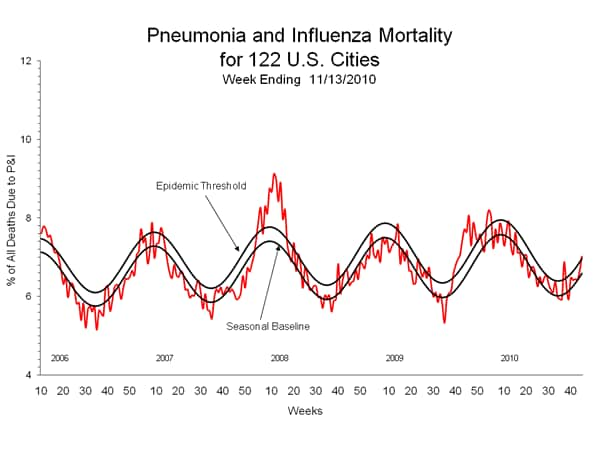# 5095
Flu Activity remains low across the United States and Canada, although there are signs that the number of cases are starting to increase.
First a look at the CDC’s latest FluView Surveillance report, then a peek at international flu trends, and we’ll wrap up with this week’s FluWatch report from Canada.
2010-2011 Influenza Season Week 45 ending November 13, 2010
All data are preliminary and may change as more reports are received.
Synopsis:
During week 45 (November 7-13, 2010), influenza activity remained low in the United States.
- Of 2,876 specimens tested by U.S. World Health Organization (WHO) and National Respiratory and Enteric Virus Surveillance System (NREVSS) collaborating laboratories and reported to CDC/Influenza Division, 220 (7.7%) were positive for influenza.
- The proportion of deaths attributed to pneumonia and influenza (P&I) was at the epidemic threshold.
- No influenza-associated pediatric deaths were reported.
- The proportion of outpatient visits for influenza-like illness (ILI) was 1.3%, which is below the national baseline of 2.5%. All 10 regions reported ILI below region-specific baseline levels; one state experienced moderate ILI activity; one state experienced low ILI activity, and 48 states experienced minimal ILI activity.
- Geographic spread of influenza in Puerto Rico and four states was reported as local; the District of Columbia and 34 states reported sporadic activity; Guam and 12 states reported no influenza activity, and the U.S. Virgin Islands did not report.
U.S. Virologic Surveillance:
WHO and NREVSS collaborating laboratories located in all 50 states and Washington D.C. report to CDC the number of respiratory specimens tested for influenza and the number positive by influenza type and subtype. The results of tests performed during the current week are summarized in the table below.


Pneumonia and Influenza (P&I) Mortality Surveillance
During week 45, 7.0% of all deaths reported through the 122-Cities Mortality Reporting System were due to P&I. This percentage was at the epidemic threshold of 7.0% for week 45.

Perhaps the most telling graphic from this week’s FluView is the 3-year pediatric flu-related mortality rate. So far this fall, only 1 child in the US has been reported to have died from influenza.
Compare that to this time last fall, when we were seeing 20 or more deaths each week.

In much of the world, the H3N2 virus (signified by red in graph below) continues to be the predominant influenza A strain, while the 2009 H1N1 virus continues to be detected at low to moderate levels.
Influenza B is the second most commonly reported flu strain around the world at this time.
And finally, from Canada’s FluWatch, this latest summary of influenza activity through November 20th.
Summary of FluWatch Findings for the Week ending November 20, 2010
- During week 46, the overall influenza activity in Canada has slightly increased. However, most of the influenza surveillance regions have reported no activity.
- The proportion of positive influenza specimens reported during week 46 has increased with 53 specimens out of 2,021 (2.62%) testing positive. Of the 53 positive tests, 17 specimens were reported as influenza A/H3N2 (ON & QC), 30 as unsubtyped influenza A (MB, ON & QC), one as pandemic H1N1 2009 (ON) and five as influenza B (BC & ON).
- Since the beginning of the season, A/H3N2 has been the predominant strain circulating in Canada representing 96% of the subtyped positive influenza A specimens. Seasonal influenza B and A/H3N2 viruses continued to co-circulate worldwide, with the later slightly predominant; pandemic H1N1 2009 virus circulation continued to be detected at low to moderate levels across Asia, and sporadically in other parts of the world.
- The Canadian Food Inspection Agency (CFIA) has confirmed the presence of low pathogenic H5N2 avian influenza virus in a commercial poultry operation in the rural municipality of Rockwood, Manitoba on November 25, 2010. The infected farm remains under quarantine and all birds in the operation will be humanely destroyed. The human health risk posed by this avian influenza virus strain is low and there have been no reports of human illness associated with this outbreak.
http://www.inspection.gc.ca/english/corpaffr/newcom/2010/20101125e.shtml
Related Post:
Widget by [ Iptek-4u ]

